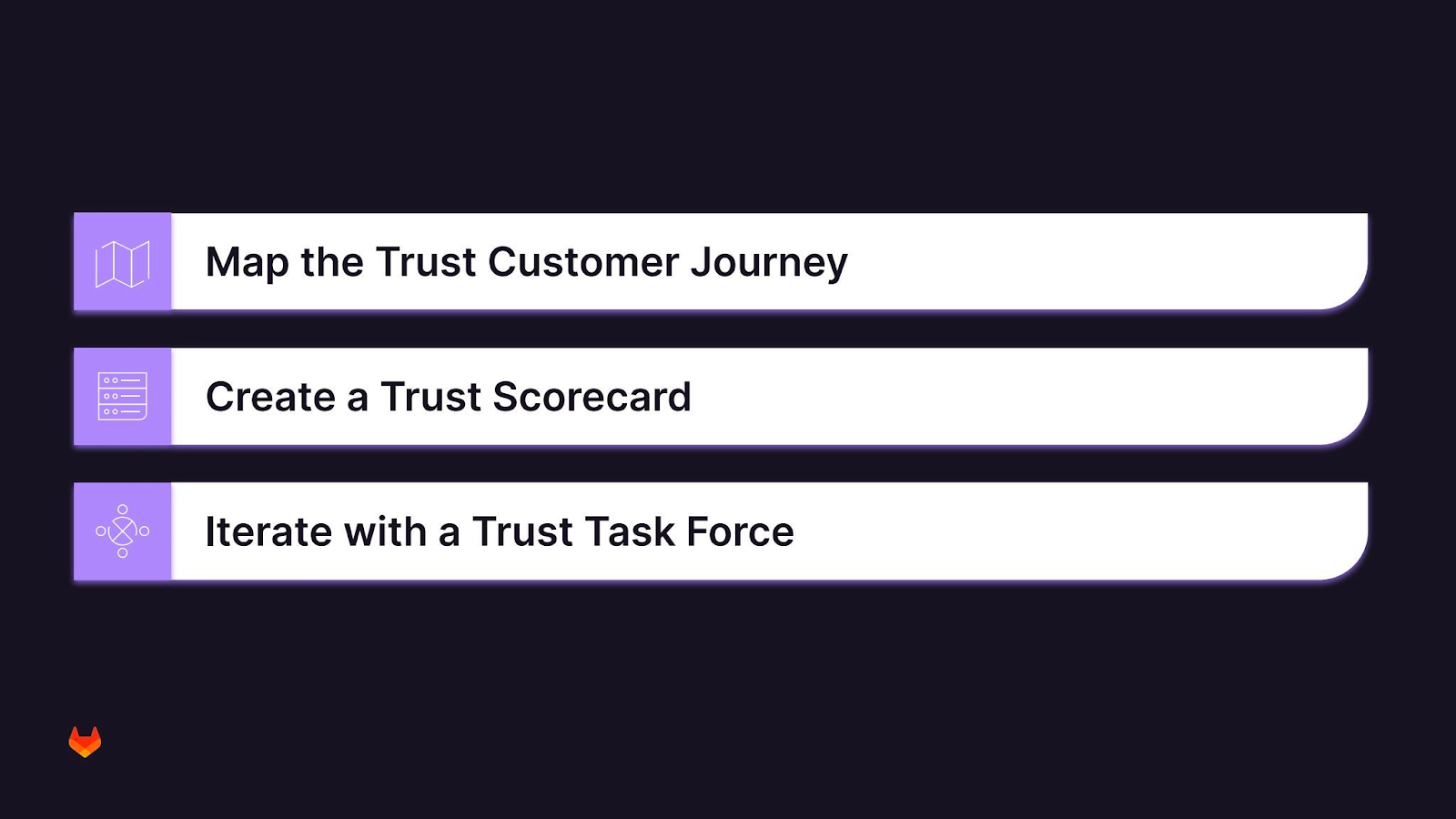This article was adapted from Dave’s talk at the Product Marketing Summit in San Francisco, hosted by our sister community, the Product Marketing Alliance. Product Marketing Alliance members can watch the complete talk on demand here.
Trust is a central part of our Go-to-Market process. Building strong brands and products revolves around it. Without our customers' trust, our brands will fail. It’s down to us to be the trust engineers of the Go-to-Market process.
Unfortunately, we face two key challenges:
- The rising levels of distrust among our audiences (more on that later!)
- The lack of a concrete framework to effectively address this distrust
While I don’t have the solution to the first problem right now, I do have a framework that’s going to empower you to build long-term trust with your customers.
Let’s get into it.
How I define trust
While there are some shared definitions of trust, we also each have our own unique takes on it. As a marketer, that can be tricky. If everyone defines trust differently, it can be quite difficult to leverage it.
To make sure we’re all on the same page, I’m going to share my personal definition of trust, and how it impacts us as Go-to-Market practitioners. For me, it boils down to four key points:
Trust is subjective and contextual
Your feelings of trust aren't going to match those of the person next to you. Trust levels can vary a lot among the audience you're trying to reach too. You might have the most brilliant customer persona mapped out, but even within that persona, there'll be differences in the level of trust people have for your brand and product.
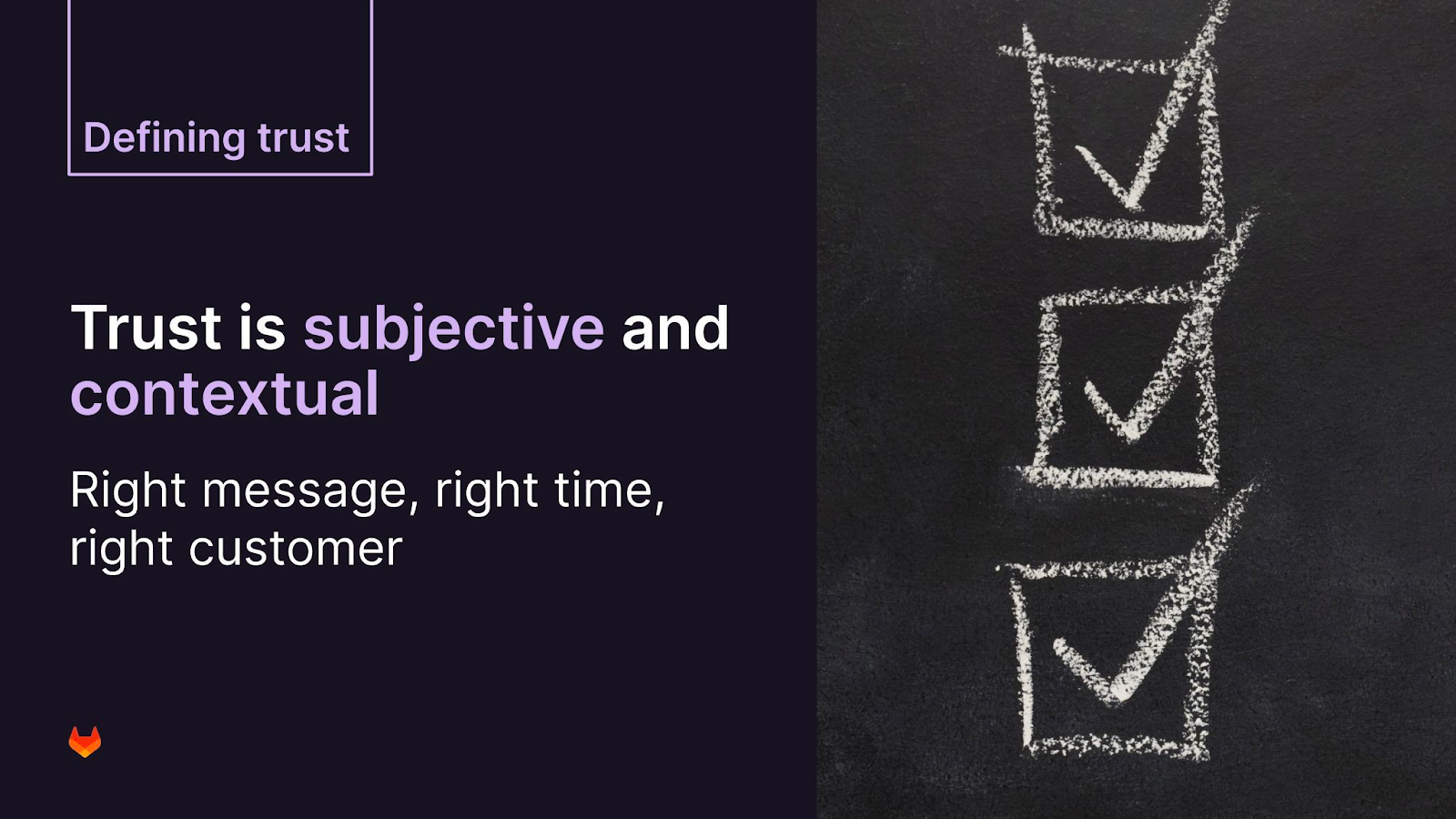
But hold on! It gets more fun – trust is also contextual. One person might trust a product in one situation, but not in another.
What does this mean for us? It means we need to get crystal clear about our customers' needs and jobs to be done. Once we understand that, we can segment our approach to messaging so we can get the right message to the right people at the right time.
Trust is a social bond
We're social creatures, so the need for trust is wired deep in our DNA. This doesn't only apply to how we interact with each other – trust is a social bond that extends to our relationships with brands and products too. It's strengthened by the idea of reliance, a give-and-take relationship between us and our customers. Understanding that mutual reliance is key to building trust into our marketing strategies.
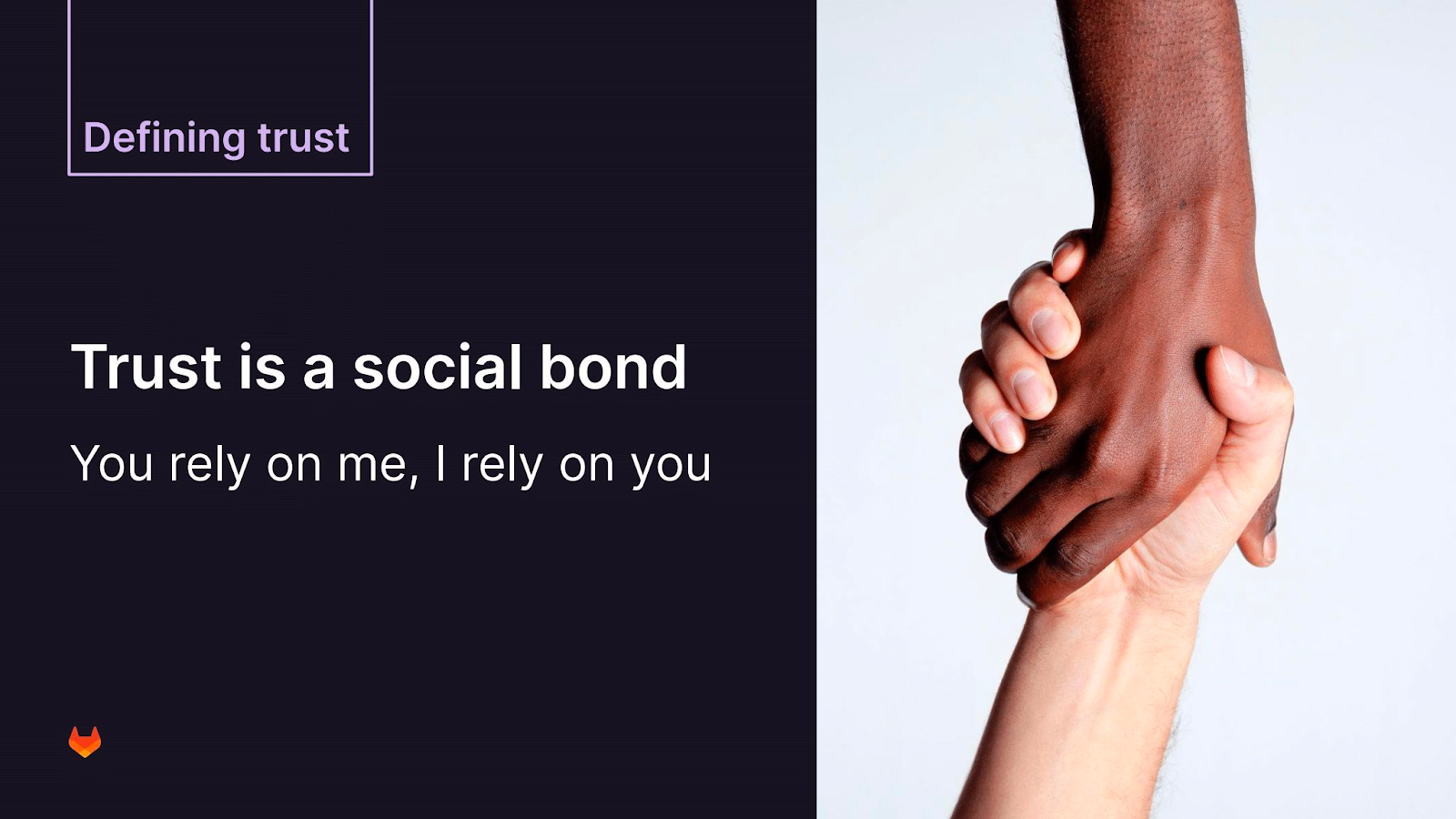
Trust is a rational and emotional cognitive assessment
When I say that trust is a rational and emotional cognitive assessment, what I mean is that it's based on belief – the belief that you'll do what you say you're going to do.
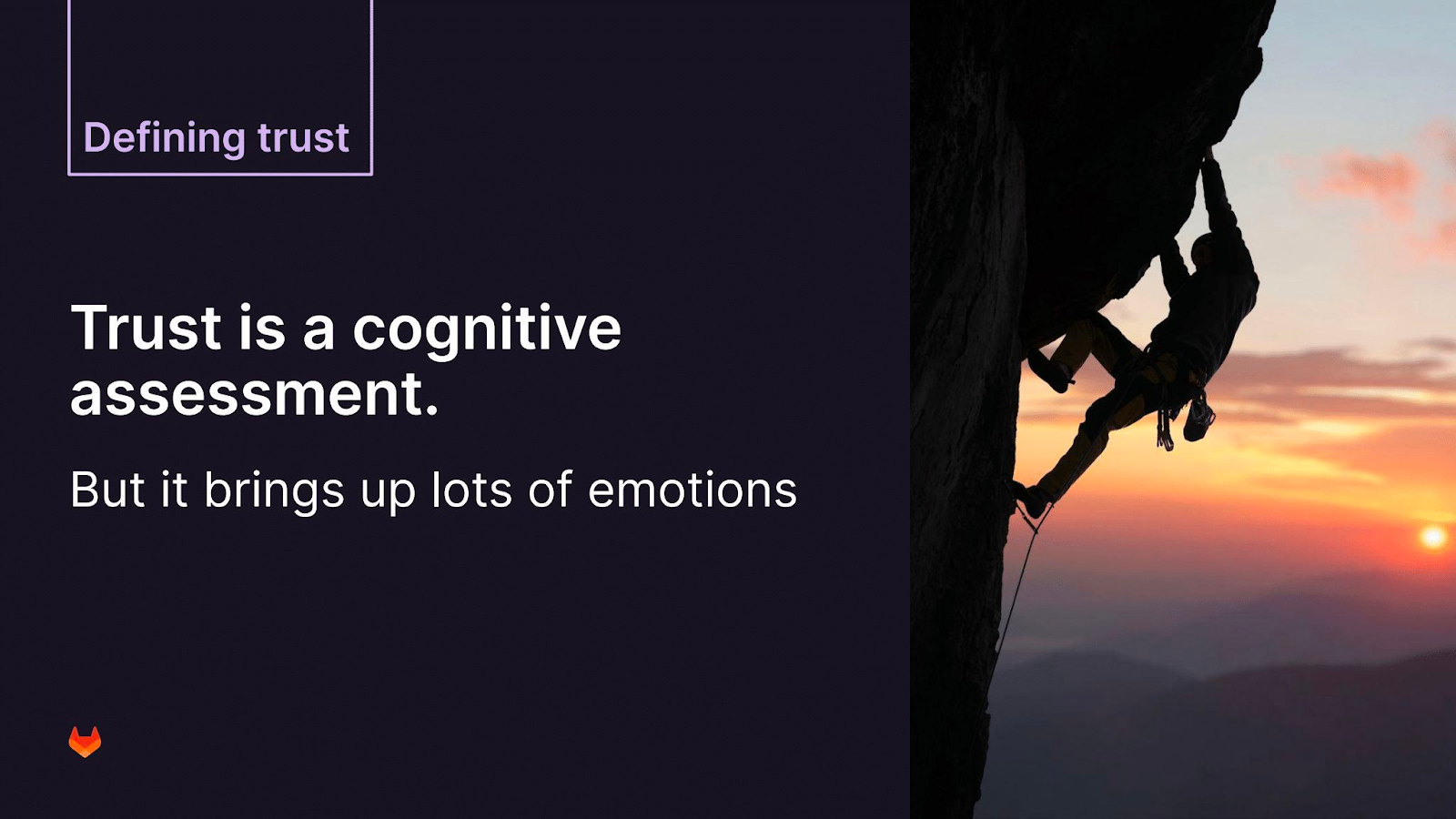
But it's not just about the rational side of things; trust is also tied to emotion. Our customers have fears and anxieties. We need to understand what those fears are at different points of the customer journey, without playing on them too much. The last thing we need is to create fear, uncertainty, and doubt because those things already exist. Instead, we need to create uplifting, aspirational, and values-driven messages that speak to these emotions.
Trust is a journey built over time
Trust doesn't pop up overnight. Think of it like a bank account – you need to deposit often and withdraw wisely to stay in the black.
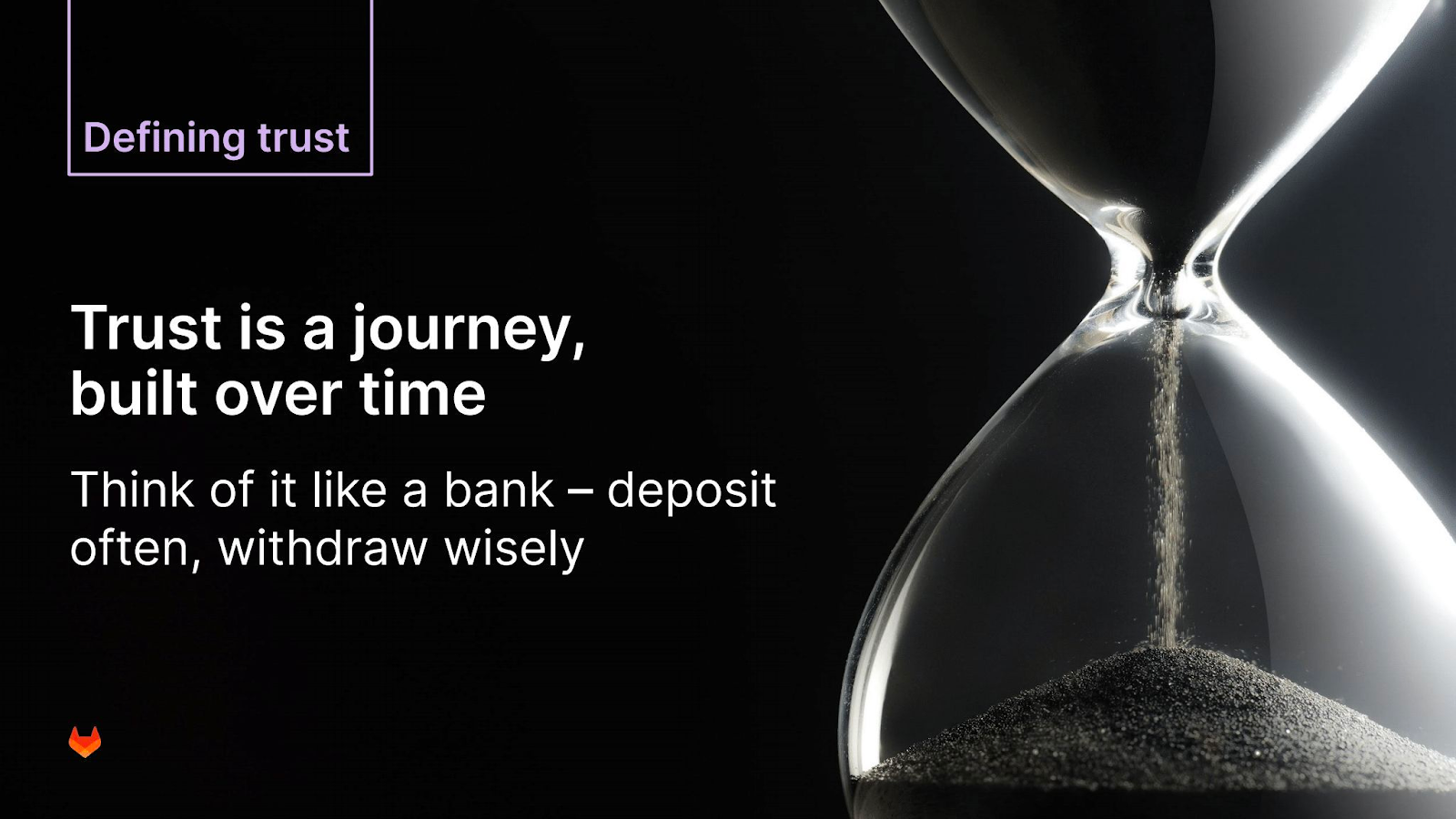
I have a colleague who's been advocating for remote work at GitLab for years. When we were discussing this trust framework, he had an "Aha!" moment. He realized that every interview he's done, every blog he's written, every white paper he’s created, and every case study he's produced was a trust deposit. It was a lightbulb moment for him, and I hope it is for you, too.

Understanding the customer’s mindset
Okay, so we've established that trust is a journey. But where on earth do we start this journey? Our starting point should always be the customer. Let's look at two key points that'll help us understand them better.
Firstly, our customers’ senses are overloaded. They are getting bombarded with advertising and brand messages every single day. One study estimated that the average consumer sees around 5000 brand messages daily, and what's their response? They tune out. That means we can't just rely on ads to get into consumers' minds and build trust. They're overloaded and, honestly, a bit fed up with us.
The second point is even more critical. Nowadays, people's go-to reaction is distrust. This is based on a survey by PR firm Edelman, which has been studying trust for the past 20 years. This year, they found out that 60% of people are now defaulting to distrust. They won't trust something until they've seen some solid proof that it's trustworthy. That means the old idea of "trust but verify" doesn't cut it anymore.
The building blocks of trust
You might be thinking, "This sounds pretty grim. What can we do about it?" Well, I've got some good news: there's a framework we can use. This framework is based on patterns I've spotted over the years, both in B2C and B2B markets, and when working with developers. It's a practical approach that I believe can make a difference.
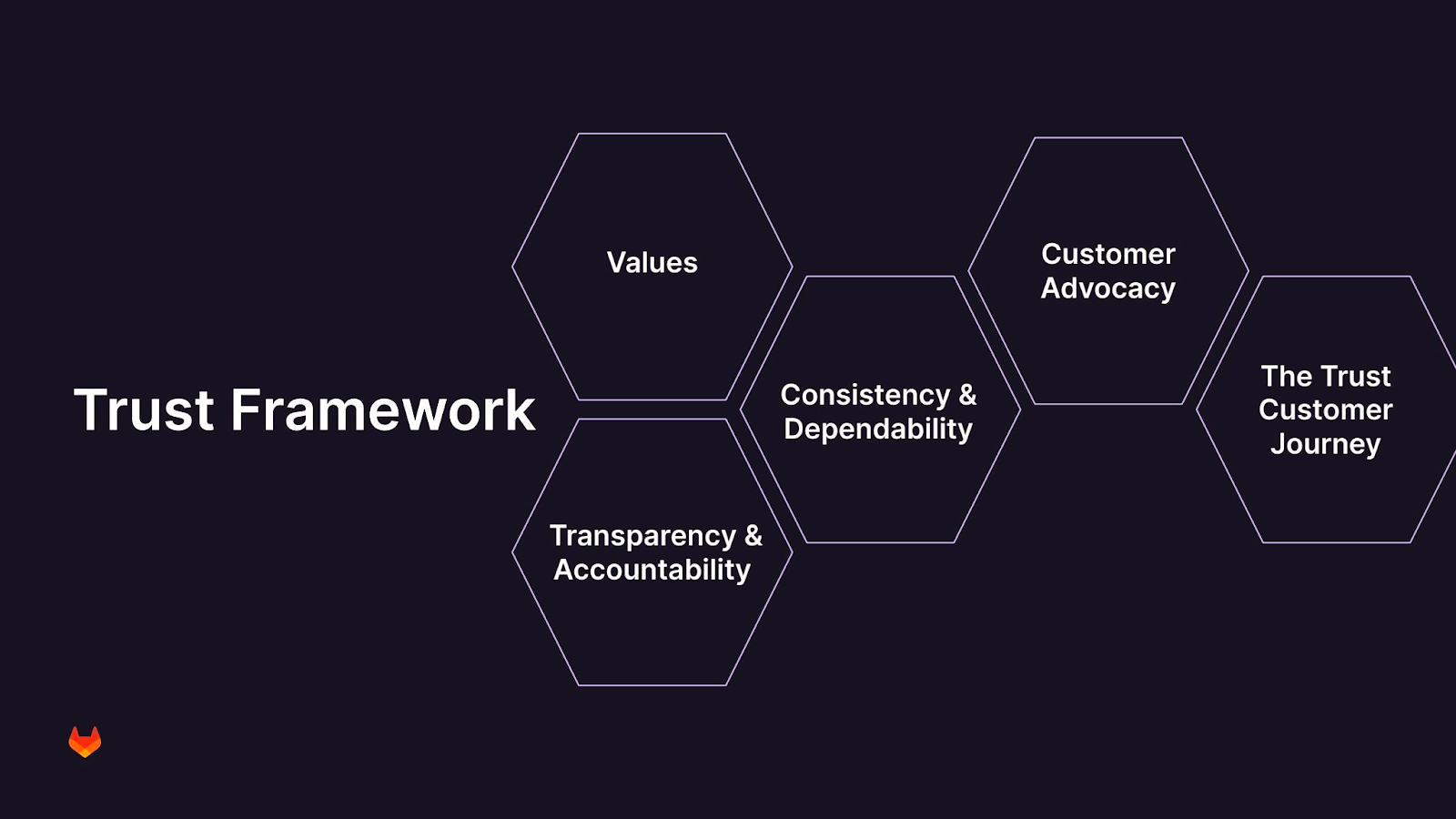
I'll also share some concrete examples from GitLab to bring the concepts to life. As we go through them, you'll start to see how you could apply the same principles to your own company.
So, let's break down this trust framework. It has five main elements:
- Values
- Transparency and accountability
- Consistency and dependability
- Customer advocacy
- The customer trust journey
Now, let’s delve into each of these pillars one by one.
Step one: creating and communicating values
First up in our trust-building framework is values. Now, what are values? They're kind of like a blueprint of what you believe in and the behaviors that you endorse. They set the standard for how folks should act, and they indicate the types of behaviors that you want to reward and encourage.
You might be thinking, "Great, values! We'll just slap some posters on the office walls saying that we're all about trust, and then we're sorted, right?" Not quite. Some folks might consider values to be just an internal thing, but the best brands out there are doing both internal and external values-driven marketing.
Why, you ask? It's because they realize that the new generation of consumers is craving brands that align with their own values. People are choosing where to work and who to buy from based on values. If your brand's values don't align with theirs, they won't feel as connected to you.
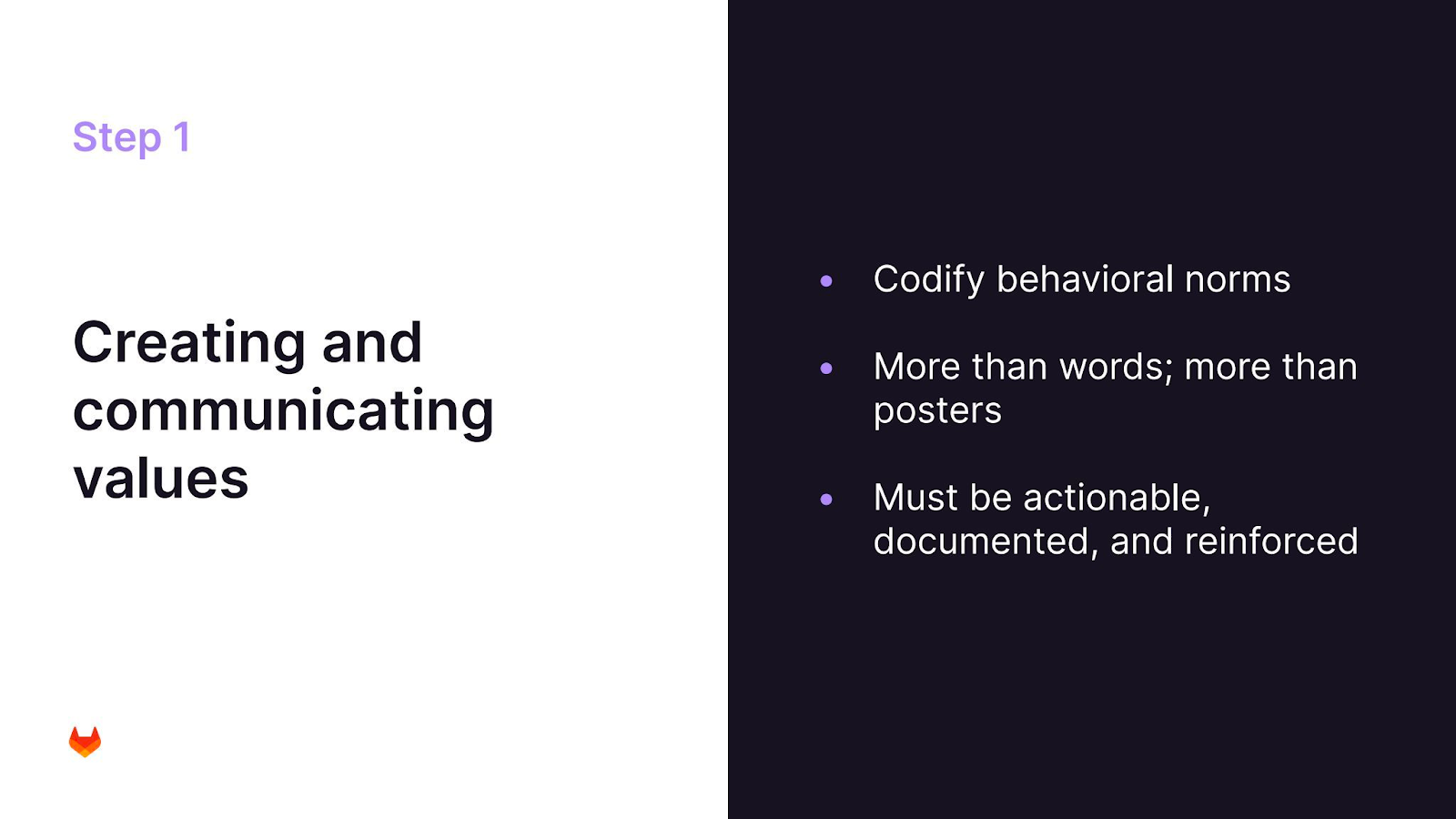
So how do we do this right? It's not just about paying lip service to your values or plastering them on your office walls. Your values need to be authentic, well-documented, and brought into your day-to-day work.
Take GitLab as an example. We've got what we call our CREDIT values: Collaboration, Results, Efficiency, Diversity, Equity and Inclusion, Iteration, and Transparency. We live by these values. After meetings, we often check in: did we really live up to our values in that conversation? And we don't just keep these values to ourselves. We make them publicly available and reference them in our external communications.
Step two: Creating transparency and accountability
The second part of our trust framework revolves around transparency and accountability. That means operating in a way that allows customers, team members, and everyone else to easily understand your actions.
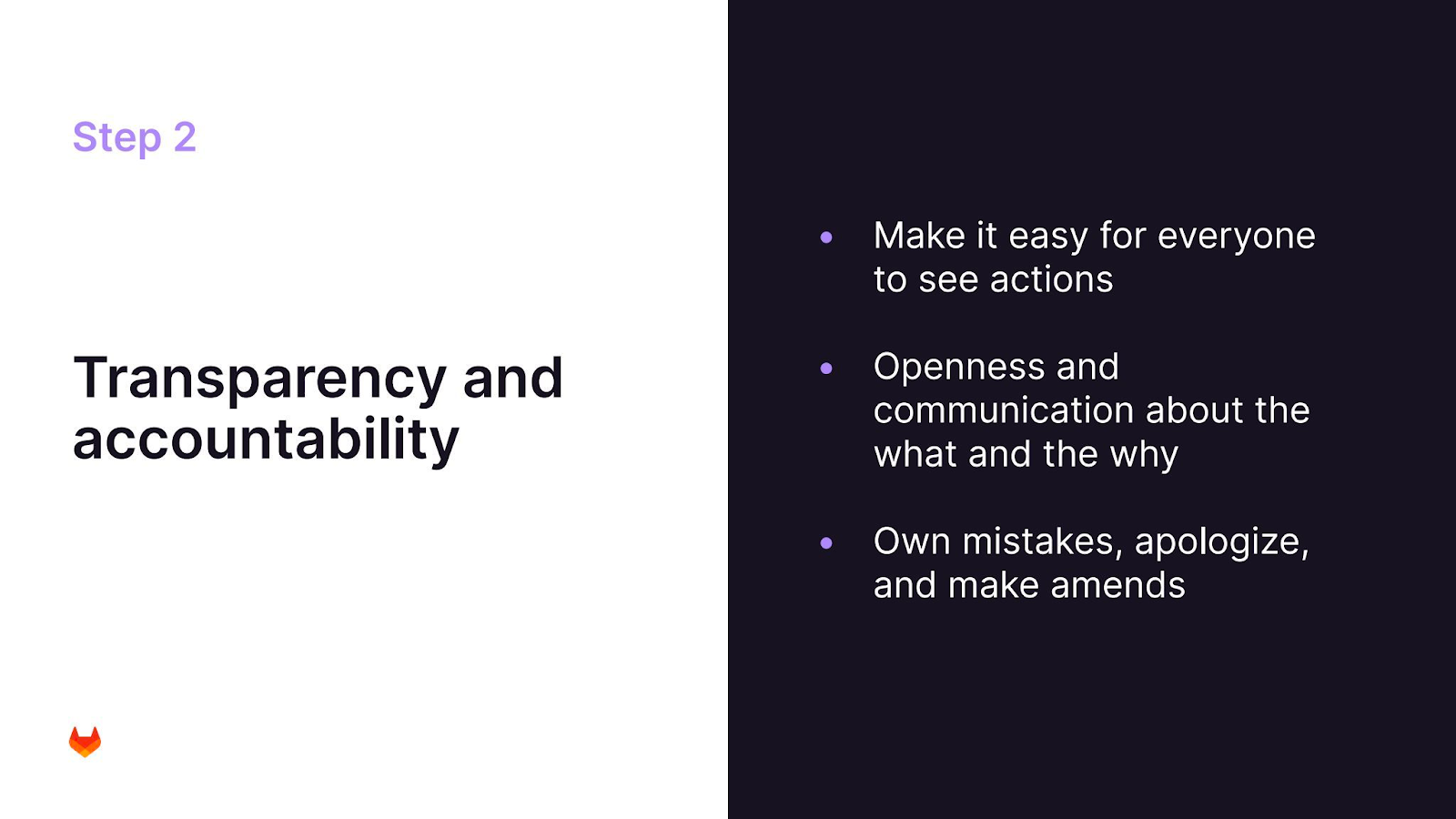
This implies openness and clear communication about both the 'what' and the 'why' – what decision did you make and why did you do it? What product did you build? Why did you build that product? This transparency about your decision-making process helps strengthen the bond of trust with your external audience.
Let's take GitLab as an example. We maintain a public handbook, which serves as a repository detailing how we run our company. It even includes my marketing strategy, messaging, positioning strategy, and personas – all accessible to anyone who's interested.
While not all companies are comfortable with this level of transparency, there's still room to think over which aspects of your processes could be more transparent. How can you invite people into your conversations? How can you demonstrate what you’re doing and why?
The other half of this trust-building duo is accountability. The basic premise is straightforward – if you make a mistake, you should acknowledge it, apologize, make amends, and then move forward.
However, this is where a lot of brands go wrong. They hope their mistakes will go unnoticed. Unfortunately, in this digital age, missteps tend to be very visible and if you try to hide them, people are going to be skeptical about your motivations.
Step three: Showing consistency and dependability
The concept of consistency and dependability can be simplified into a straightforward equation: trust equals consistency over time.
There are two important factors to note here. First, trust doesn't develop overnight; it's the result of repeated, consistent experiences that compound over time. Second, you need to be consistent so that your audience can depend on you. This includes consistency in your messaging and your customer experiences. If you’re constantly changing things up, you’re undermining this vital component of trust.
Let’s go back to the bank metaphor: deposit often and withdraw wisely. This doesn't mean you should never change your product – you might need to change in response to new insights or evolving customer needs. However, you should be careful about how you make these changes. Any changes should be tied to customer needs and the reasons behind them should be communicated clearly.
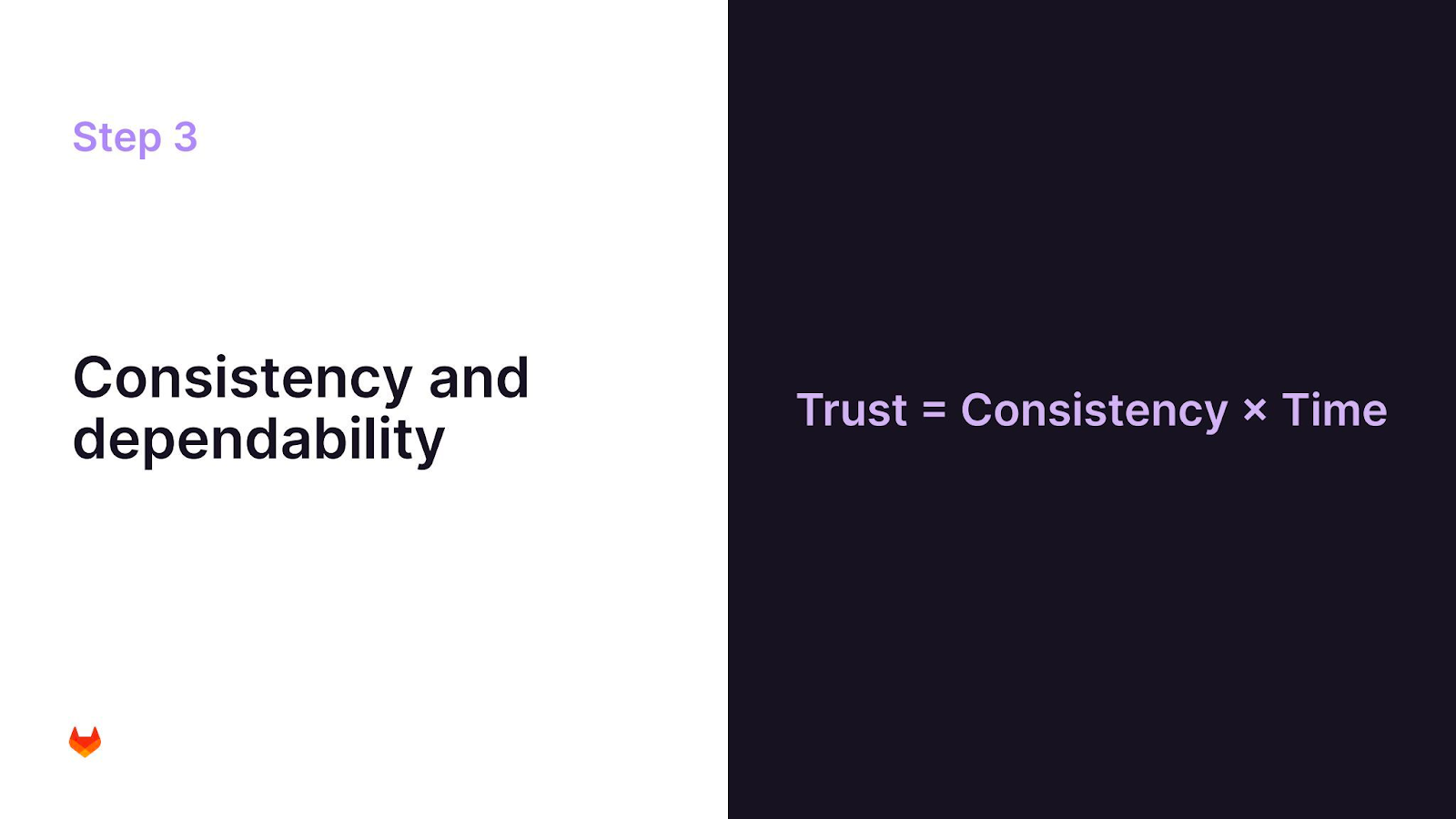
Let’s take a look at how GitLab shows consistency. We ship a new version of GitLab on the 22nd of every month, like clockwork, and have been doing so for over 130 months. The first five times we did that, it might not have seemed like a big deal, but after 10 times, people started to take note. After 130 times, it's become something our community and customers expect and rely on. Many have even structured their own processes around our predictable delivery.
This consistency builds a lot of trust, especially when combined with our open-core model that allows users to contribute to the product.
So, perhaps it’s time to consider how you can embed consistency into your operational processes. What strategies can you implement that deliver the consistency your customers want?
Step four: Encouraging customer advocacy
The fourth and arguably most important pillar of our trust framework is customer advocacy. The strength of customer voices and stories is not to be underestimated. Your audience craves proof from customers like them.
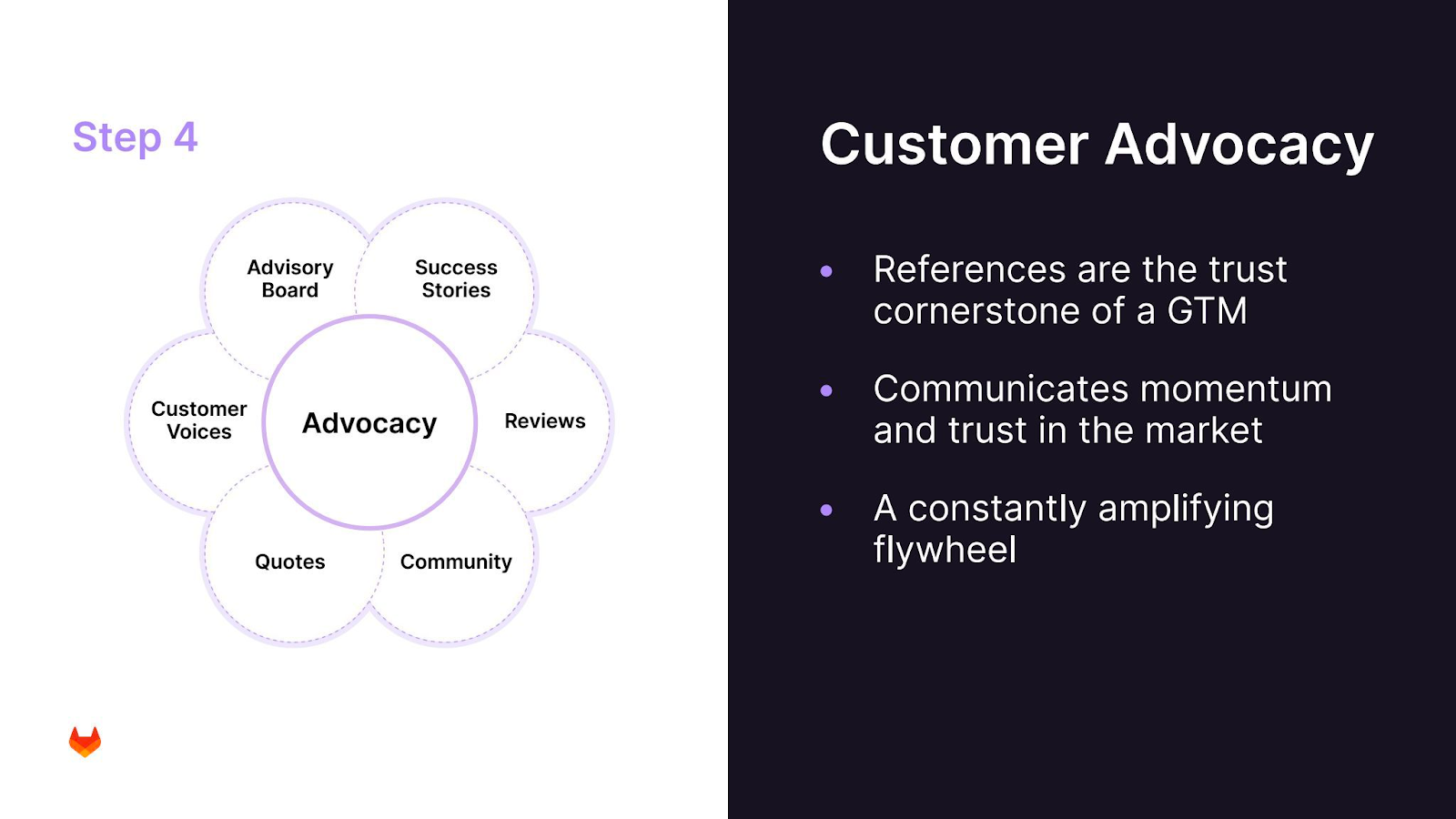
You should approach customer advocacy as a holistic program, involving not just case studies, but also advisory boards, and anything you can do to identify, recruit, and amplify the voice of the customer. That’s going to help you build momentum and trust in the market.
Step five: The customer trust journey
Alongside the traditional buyer's journey of awareness, consideration, and purchase, there's a trust journey. It starts with awareness, moves into what I call 'reputed trust', and then 'earned trust'. Reputed trust is essentially your reputation or brand – what people think of you. However, the ultimate goal is to reach earned trust, and our job is to guide people from reputed trust to earned trust. The only way to do that is through experiences.
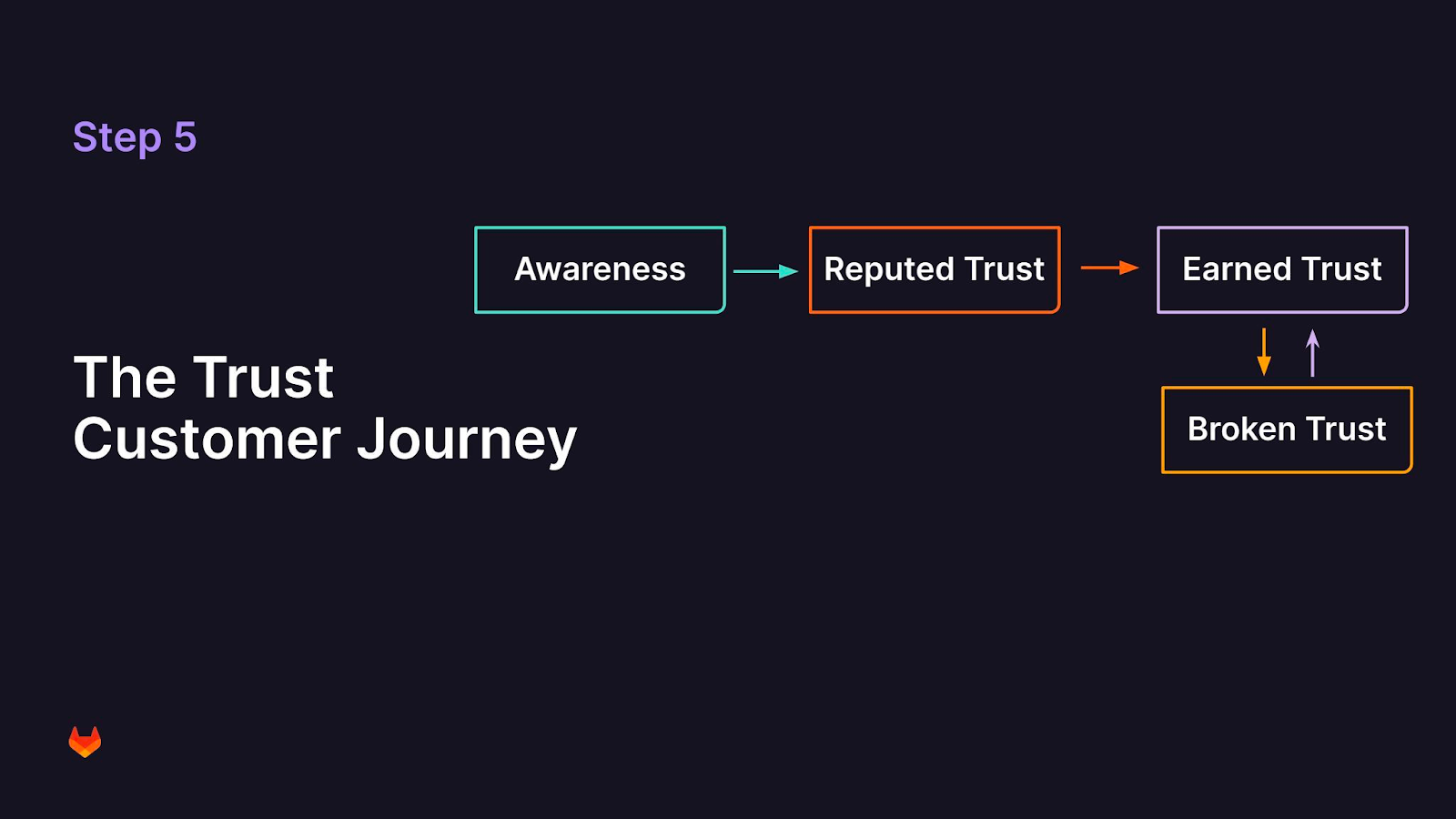
But what if something goes awry? That’s when it’s time to revert to the first pillar: transparency and accountability. Understand the problem, communicate about it, make amends, and then move on.
Contrary to what many people think, the deepest erosion of trust doesn't necessarily happen when there's a single betrayal or error; we can all think of brands that made mistakes, quickly apologized, and successfully moved on. In my view, the worst thing a brand can do is to withdraw or stop caring about their customers' needs and wants.
We can prevent this brand withdrawal by continuously being the voice of the customer, prioritizing this voice in all decision-making processes, communicating transparently, and consistently meeting customer needs. It’s down to us to ensure customers never feel neglected or unheard as we build out our go-to-market strategies
How you can start building trust today
While trust might seem overwhelming or nebulous, it doesn't have to be. Before I wrap up, here are three tangible steps you can take immediately to begin cultivating trust:
- Map the customer journey: Outline each customer touchpoint with your brand or product. Identify the questions they're likely asking and the anxieties they might have at each stage, then develop programs or messages to address these concerns.
- Create a trust scorecard: Remember, if you can't measure it, you can't manage it. I like to develop my scorecards using metrics such as net promoter score, customer satisfaction ratings, and tracking changes in brand attributes over time. Ideally, you want to see attributes like "this brand is for a person like me" on the rise. And, of course, the financial gold standard is net dollar retention – an increase in business with you indicates that customers trust you more and find value in your service.
- Iterate with a trust taskforce: Trust is not owned by any one individual within a company. Find your posse, bring them together, and form a task force. Experiment with programs and initiatives and continually evaluate your progress using the metrics you've identified.
